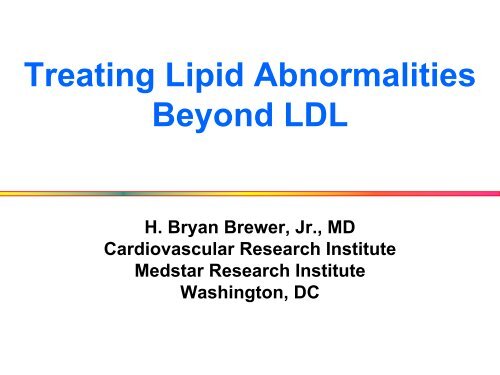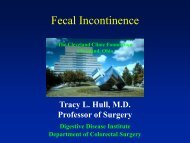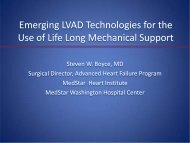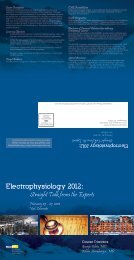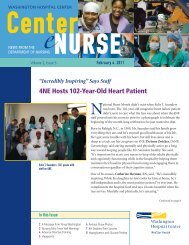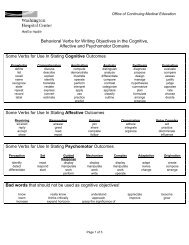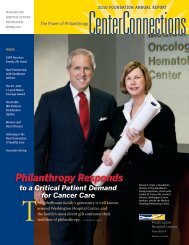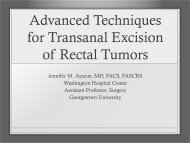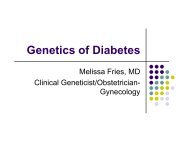Treating Lipid Abnormalities Beyond LDL - Washington Hospital ...
Treating Lipid Abnormalities Beyond LDL - Washington Hospital ...
Treating Lipid Abnormalities Beyond LDL - Washington Hospital ...
You also want an ePaper? Increase the reach of your titles
YUMPU automatically turns print PDFs into web optimized ePapers that Google loves.
<strong>Treating</strong> <strong>Lipid</strong> <strong>Abnormalities</strong><br />
<strong>Beyond</strong> <strong>LDL</strong><br />
H. Bryan Brewer, Jr., MD<br />
Cardiovascular Research Institute<br />
Medstar Research Institute<br />
<strong>Washington</strong>, DC
Disclosure<br />
• Consulting Agreements: Merck & Co.; Pfizer Inc;<br />
Sanofi; AstraZeneca; Roche; Genentech; InfraReDx<br />
• Speakers’ Bureau/Honorarium Agreements: Merck &<br />
Co.; Roche; Genentech; Pfizer Inc; Sanofi;<br />
AstraZeneca; InfraReDx; HDL Therapeutics<br />
• Financial Interests/Stock Ownership: Medicines<br />
Company; InfraReDx, HDL Therapeutics
THE PYRAMID OF CVD<br />
TRIALS<br />
Very high cholesterol<br />
with CHD or MI<br />
Moderately high cholesterol<br />
in high-risk CHD or MI<br />
Normal Cholesterol<br />
with CHD or MI<br />
High cholesterol with<br />
NO CHD or MI<br />
No history of CHD or MI, average TG<br />
and <strong>LDL</strong>-C, but below average HDL-C<br />
Comparison of coronary clinical events with<br />
<strong>LDL</strong> reduction by pravastatin and atorvastatin<br />
No history of CVD with Normal <strong>LDL</strong> and Increased CRP<br />
4S<br />
PLAC I/II, KAPS, REGRESS<br />
CARE<br />
WOSCOPS<br />
AFCAPS/TexCAPS<br />
PROVE -IT<br />
JUPITER<br />
HPS Collaborative Group. Lancet. 2002;360(9326):7-22; LaRosa JC, et al. N Engl J Med. 2005;352(14):1425-1435; 4S Group. Lancet.<br />
1994;344(8934):1383-1389; Sacks FM, et al. N Engl J Med. 1996; 335(14):1001-1009; Shepherd J, et al. N Engl J Med. 1995; 333(20):1301-<br />
1307; Downs JR, et al. JAMA. 1998;279(20):1615-1622; Cannon CP, et al. N Engl J Med. 2004;350(15):1495-1504; Circulation.
Percent Decrease in Cardiovascular Risk<br />
RESIDUAL CARDIOVASCULAR RISK IN STATIN TREATED<br />
PATIENTS<br />
0<br />
25<br />
50<br />
75<br />
100<br />
4S WOS CARE HPS<br />
<strong>LDL</strong><br />
62 mg/dL<br />
Prove<br />
It<br />
<strong>LDL</strong><br />
77 mg/dL<br />
TNT<br />
CTT Meta<br />
Analysis<br />
<strong>LDL</strong><br />
54 mg/dL<br />
Jupiter<br />
30% 31% 24% 24% 16% 24% 24% 56%<br />
Percent Decrease in Cardiovascular Risk<br />
70% 69% 76% 76% 84% 76% 76% 44%<br />
Percent Residual Risk in Cardiovascular Risk
UNMET CLINICAL<br />
NEED<br />
TREATMENT OF THE<br />
RESIDUAL<br />
CARDIOVASCULAR<br />
DISEASE
HDL: The Next Frontier in the Treatment<br />
of the Residual Cardiovascular Risk in<br />
Statin Treated Patients<br />
<strong>LDL</strong><br />
HDL
Lipoprotein Metabolism in Patients<br />
with Increased <strong>LDL</strong> and Decreased HDL<br />
Intestine<br />
Liver<br />
<strong>LDL</strong>r<br />
B-100<br />
E Triglycerides<br />
C-III<br />
V<strong>LDL</strong><br />
V<strong>LDL</strong><br />
αHDL<br />
CETP<br />
<strong>LDL</strong><br />
Modification<br />
Arterial Wall<br />
Macrophage
Clinical Practice<br />
Characteristic Dyslipoproteinemia<br />
in Patients With Residual<br />
In Statin Treated<br />
Patients HDL<br />
Remains an<br />
Independent Risk<br />
Factor<br />
Cardiovascular Risk
LOW HDL-C AS A RESIDUAL RISK FACTOR<br />
FOR CARDIOVASCULAR EVENTS IN TNT<br />
Secondary Prevention TRIAL - Stable Cardiovascular Disease<br />
Major Cardiovascular Event<br />
Frequency (%)<br />
14<br />
12<br />
10<br />
8<br />
6<br />
4<br />
2<br />
0<br />
54<br />
HDL-C quintile (mg/dL)<br />
>100<br />
70-100<br />
Clinical Practice<br />
Characteristic Dyslipoproteinemia<br />
in Patients With Residual<br />
Cardiovascular Risk<br />
In Statin Treated<br />
Patients HDL<br />
Remains an<br />
Independent Risk<br />
Factor<br />
Increased Tg +<br />
Dense <strong>LDL</strong> +<br />
Decreased HDL<br />
Metabolic Syndrome<br />
Diabetes
THE BEGINNING …
The Super Sized Life Style<br />
WALKING THE DOG
THE RESULT…<br />
OF THE SUPER SIZED LIFE STYLE<br />
Brewer 2010
Visceral Obesity And Cardiovascular<br />
Risk
Current Insights into<br />
the Mechanisms of How<br />
HDL Protects Against<br />
Cardiovascular Disease
Current Insights into the Mechanisms by Which<br />
HDL Protects Against Cardiovascular Disease<br />
Cholesterol<br />
Efflux<br />
HDL
<strong>Lipid</strong> Poor ApoA-I and αHDL<br />
αHDL is the<br />
Ligand for the<br />
ABCG1 Transporter<br />
Cellular Cholesterol Efflux<br />
“Dual Pathway”<br />
LCAT<br />
αHDL<br />
αHDL<br />
<strong>LDL</strong><br />
LCAT<br />
αHDL<br />
A-I<br />
ABCG<br />
1<br />
Preβ-HDL<br />
αHDL<br />
ABCA1<br />
Mediated<br />
Preβ-HDL is the<br />
Ligand for the<br />
ABCA1 Transporter
CURRENT WORKING<br />
MODEL OF HDL AND<br />
CHOLESTEROL<br />
METABOLISM
Intestine<br />
ApoA-I<br />
Current Model of HDL Metabolism<br />
Cholesterol<br />
ApoA-I<br />
ABCA1<br />
A-I<br />
A-I<br />
A-I<br />
A-I<br />
ABCA1<br />
A-I<br />
Liver<br />
A-I<br />
<strong>Lipid</strong> Poor ApoA-I<br />
SR-B1<br />
<strong>LDL</strong>r<br />
A-I A-I<br />
CETP<br />
<strong>LDL</strong><br />
SR-B1<br />
Modification<br />
ABCG1<br />
ABCA1<br />
LCAT Macrophage<br />
A-I<br />
A-I
Current Insights into the Mechanisms by Which<br />
HDL Protects Against Cardiovascular Disease<br />
Cholesterol<br />
Efflux<br />
HDL<br />
Anti-<br />
Inflammatory<br />
Properties
COLLAR-INDUCED CHANGES IN ENDOTHELIAL<br />
EXPRESSION OF VCAM-1 and ICAM-1 FOLLOWING<br />
EITHER a SALINE OR rHDL Infusion .<br />
Collar-induced Change<br />
3<br />
2<br />
1<br />
0<br />
VCAM-1 ICAM-1<br />
Saline<br />
***<br />
rHDL<br />
Barter P. et al Circ. Res. 2004, 95: 764-772<br />
Saline<br />
**<br />
rHDL<br />
1.5<br />
1.0<br />
0.5<br />
0.0<br />
Collar-induced Change
NEUTROPHIL IMMUNOHISTOCHEMICAL<br />
STAINING In COLLARED CAROTID ARTERY<br />
INFUSED WITH EITHER SALINE OR rHDL<br />
Saline rHDL<br />
Nicholls. S.J. Arter. Throm. Vasc. Biol 2005
Current Insights into the Mechanisms by Which<br />
HDL Protects Against Cardiovascular Disease<br />
Cholesterol<br />
Efflux<br />
HDL<br />
Anti-<br />
Inflammatory<br />
Properties<br />
Protect<br />
<strong>LDL</strong> From<br />
Oxidation
Major Mechanisms Involved in the HDL<br />
Mediated Protection Against<br />
Cardiovascular Disease<br />
Protect<br />
Oxidation<br />
HDL<br />
<strong>LDL</strong> Against Oxidation<br />
Oxidation<br />
Ox-<strong>LDL</strong><br />
�<br />
Ox-HDL<br />
Paraoxonase (PON)<br />
� LCAT<br />
LpPLA2<br />
�
Current Insights into the Mechanisms by Which<br />
HDL Protects Against Cardiovascular Disease<br />
Stem<br />
Cells<br />
Transport<br />
Particle<br />
Cholesterol<br />
Efflux<br />
HDL<br />
Endothelial<br />
Function<br />
Anti-<br />
Inflammatory<br />
Properties<br />
Protect<br />
<strong>LDL</strong> From<br />
Oxidation
Clinical Assesment<br />
of HDL<br />
Functional vs.<br />
Dysfunctinal HDL
Potential Mechanisms Involved in<br />
the Generation of Dysfunctional HDL<br />
Dysfunctional<br />
Lyso<br />
PC<br />
Dysfunctional HDL<br />
Ox. PL<br />
HDL<br />
Oxidation<br />
sPLA 2<br />
HDL<br />
Glycation in<br />
Diabetes<br />
Myeloperoxidase<br />
Foger B, et al. J Biol Chem. 1999;274(52):36912-36920.<br />
Ansell BL, et al. Curr Opin <strong>Lipid</strong>ol. 2007;18(4):427-434.<br />
Nicolls SJ , et al. Trends Cardiovasc Med. 2005;15(6):212-221.<br />
Shao B, et al. Curr Opin Mol Ther 2006;8(3):198-205.<br />
N0 2<br />
Dysfunctional HDL<br />
Cl<br />
Dysfunctional HDL
Evidence to Support<br />
Increasing HDL will Decrease<br />
Cardiovascular Disease<br />
�<br />
Pre-Clinical: Animal Models That<br />
Increasing HDL Will Decrease<br />
Atherosclerosis.
Increasing HDL By Infusion of HDL,<br />
Overexpression of the ApoA-I or LCAT Genes<br />
Decreases Atherosclerosis<br />
Infuse HDL<br />
Control<br />
HDL Infused<br />
Badimon et al J. Clin<br />
Invest 1990:85,1234-1241<br />
Increase A-I Gene<br />
Plump et al Proc Natl Acad<br />
Sci 1994:91, 9607- 9611.<br />
Increase LCAT Gene<br />
Hoeg et al Proc Natl Acad<br />
Sci 1996 93:11448- 11453
Evidence to Support<br />
Increasing HDL will Decrease<br />
Cardiovascular Disease<br />
�Pre-Clinical:<br />
Animal Models That<br />
Increasing HDL Will Decrease<br />
Atherosclerosis.<br />
�<br />
Clinical and Imaging: Evidence<br />
That Increasing HDL Will Decrease<br />
Clinical Events and Coronary<br />
Atherosclerosis.<br />
1. Niacin
HDL Targeted Therapies:<br />
Niacin<br />
1. Decreases <strong>LDL</strong>, increases HDL and reduces<br />
triglycerides<br />
2. Anti-inflammatory<br />
3. Decreases plasma FFA<br />
4. Increases homocysteine<br />
5. Increases uric acid<br />
6. Increases blood glucose<br />
7. Binds to DP2 receptor and causes flushing
Clinical Outcome in Coronary Drug Project**<br />
Event Rate (%)<br />
35<br />
30<br />
25<br />
20<br />
15<br />
10<br />
5<br />
0<br />
-14%*<br />
Nonfatal MI/CD<br />
Death<br />
-27%*<br />
Nonfatal<br />
MI<br />
-26%*<br />
Stroke/<br />
TIA<br />
Placebo<br />
Niacin<br />
-47%*<br />
CV<br />
Surgery<br />
JAMA 1975;231:360-381 *P
HATS: Angiographic and Clinical Endpoints<br />
Change in Stenosis, %<br />
4.0<br />
3.5<br />
3.0<br />
2.5<br />
2.0<br />
1.5<br />
1.0<br />
0.5<br />
0.0<br />
-0.5<br />
+3.9<br />
*<br />
-0.4<br />
Placebo Statin + Niacin<br />
*p
Arbiter 3: Changes in CIMT in Patients Treated<br />
With Statins or Statins + Niacin<br />
Average Change in CIMT For All<br />
Drug Periods (mm)<br />
-<br />
-<br />
-<br />
.075<br />
.050<br />
.025<br />
0<br />
.025<br />
.050<br />
.075<br />
N =<br />
61<br />
Statin<br />
Progression<br />
Regression<br />
N = 125<br />
Statin + Niacin<br />
12 Months<br />
Treatment Period<br />
Taylor A. et al Curr. Med. Res. Opin. 2006:22,2243-2250<br />
N = 67<br />
24 Months
�<br />
�<br />
Aim High randomized 3414 patients with established<br />
CVD– 85% men<br />
� 34% Diabetic and 81% Metabolic Syndrome<br />
�<br />
Patients will receive simvastatin +/- Ezetimibe<br />
to target <strong>LDL</strong>-C to 40-80 or simvastatin<br />
+/- Ezetimibe + niacin<br />
Baseline lipids: <strong>LDL</strong>- C = 71 mg/dl, HDL-C = 34.9<br />
mg/dl, Tg = 161 mg/dl.<br />
� Trial Terminated May 2011<br />
AIM HIG Investigators. Am Heart J. 2011;161(3):538-543.<br />
35
�<br />
�<br />
THRIVE will involve a total of 25,000 men and<br />
women<br />
� 8,500 participants will be from the UK<br />
� 10,500 participants will be from China<br />
� 6,000 participants will be from Scandinavia<br />
Patients will receive 40 mg simvastatin +/- Ezetimibe<br />
to target <strong>LDL</strong>-C to 77 mg/dl or 40 mg simvastatin<br />
+/- Ezetimibe + niacin/laropaprant .<br />
� Completion Date 2013<br />
36
Change in IVUS Total Atheroma Volume<br />
15.0 Progression<br />
5.0<br />
Change in Total Atheroma Volume<br />
0.0<br />
10.0<br />
-5.0<br />
- 10.0<br />
- 15.0<br />
in Clinical Trials<br />
ApoA-I Milano<br />
Placebo All Doses<br />
Regression<br />
Asteriod<br />
Reversal<br />
Pravastatin Atorvastatin<br />
Nicholls S et al JAMA 2007;297:499-508; Nissen S et al NEJM 2007;356:499-508
Evidence to Support HDL as a<br />
Therapeutic Target for the Treatment<br />
√<br />
√<br />
√<br />
of High Risk Patients with<br />
Cardiovascular Disease<br />
Epidemiological Evidence That HDL is an<br />
Independent Risk Factor for Cardiovascular Disease<br />
Prevalence of Low HDL as an Important Risk Factor.<br />
√ Clinical and Imaging Evidence That Increasing HDL<br />
√<br />
Identification of Mechanisms by Which HDL<br />
Decreases Atherosclerosis<br />
Evidence in Animal Models That Increasing HDL Will<br />
Decrease Atherosclerosis.<br />
Will Decrease Clinical Events and Coronary<br />
Atherosclerosis.
Future HDL Targeted<br />
Therapies<br />
1. Preβ-HDL Infusion Therapy
Intestine<br />
Preβ-HDL Removes Cholesterol<br />
Liver<br />
SR-<br />
B1<br />
αHDL<br />
ONLY 5% of HDL is In the Preβ-HDL<br />
Form to Remove Cholesterol from<br />
the Cell<br />
Concept Acute HDL Therapy:<br />
Infuse Preβ-HDL to Increase<br />
Cholesterol Removal from Cells<br />
From <strong>Lipid</strong> Filled Plaques<br />
<strong>LDL</strong>r<br />
A-I<br />
95%<br />
LCAT<br />
CETP<br />
<strong>LDL</strong><br />
A-I<br />
A-I<br />
A-I<br />
Preβ-HDL<br />
ABCA<br />
1<br />
<strong>Lipid</strong> Filled<br />
Macrophage<br />
in the Heart
Preβ-HDL Infusion Reduced Arterial<br />
<strong>Lipid</strong> Stain in<br />
the Artery<br />
<strong>Lipid</strong> Filled<br />
Macrophage<br />
Stain in the<br />
Artery<br />
<strong>Lipid</strong> Content in Animal Models<br />
Control ApoA-I Milano<br />
Shah PK,et al. Circulation 2001;103:3047-3050<br />
Control Saline<br />
Infusion<br />
ApoA-I Milano<br />
Infusion<br />
Chiesa G, et al. Circ. Res. 2002:90;974-980<br />
41
IVUS Analysis of the Effect of Preβ-HDL Infusions on<br />
Coronary Plaques in ACS Patients<br />
Protocol for Infusions in ACS Patients<br />
Day 0 1 2 3 4 5 6 7 8<br />
Treatment<br />
Treatment Arm<br />
Control Arm<br />
4 to 7 Weekly Infusions<br />
IVUS IVUS<br />
or Control<br />
Plasma Infusion<br />
Brewer
Preβ-HDL Enriched Plasma Obtained<br />
by HDL Selective Delipidation<br />
Plasma Bag 1<br />
Plasma Collected<br />
A-I<br />
αHDL Preβ-HDL<br />
95% 5%<br />
Waksman R, et al . J Am Coll<br />
Card.2010;55:2727‐2735.<br />
Preβ Enriched Plasma Obtained By<br />
Selective HDL Delipidation<br />
A-I<br />
Preβ-HDL<br />
Plasma Bag 2<br />
Preβ Enriched Plasma<br />
A-I<br />
A-I<br />
A-I<br />
A-I A-I<br />
αHDL Preβ-HDL<br />
20% 80%
Plaque Reduction in the Selective HDL<br />
Delipidation Human Clinical Trial and ApoA-I<br />
Milano Trial were Similar<br />
Variable (mean ± SD)<br />
HDL Delipidation<br />
Therapy Trial*<br />
n = 14<br />
Change in Total Atheroma<br />
Volume (mm 3 ) -12.18 ±<br />
Change in Percent Atheroma<br />
Volume - Plaque Burden -1.0% ±<br />
Change in Most Diseased 10<br />
mm Segment Atheroma<br />
Volume (mm 3 )<br />
*Waksman R, et al. J Am Coll Card. 2010;55:2727-2735<br />
-6.24 ±<br />
ApoA-I Milano<br />
Trial<br />
n = 36<br />
36.75 -14.10 ±<br />
4.0% -1.1% ±<br />
17.94 -7.20 ±<br />
39.50<br />
3.2%<br />
12.60<br />
Nissen S,et al. JAMA 2003;290:2292-2300.
The Reduction in Plaque was Greater in the HDL<br />
Selective Delipidation Human Trial Than the Results<br />
Obtained with Atorvastatin in the REVERSAL Trial<br />
Variable (mean ± SD)<br />
Change in Total Atheroma<br />
Volume (mm 3 ) -12.18 ±<br />
Change in Percent<br />
Atheroma Volume -<br />
Burden<br />
Plaque<br />
Change in Most Diseased<br />
10 mm Segment Atheroma<br />
Volume (mm 3 )<br />
+ P
Future HDL Targeted<br />
Therapies<br />
1. Preβ-HDL Infusion Therapy<br />
2. CETP Inhibitors
Intestine<br />
ApoA-I<br />
Lipoprotein Profile with CETP Inhibition<br />
ApoA-I<br />
ABCA1<br />
Liver<br />
<strong>Lipid</strong> Poor ApoA-I<br />
SR-B1<br />
<strong>LDL</strong>r<br />
A-I A-I A-I<br />
HDL-ML,VL, (α1) LCAT<br />
CETP<br />
<strong>LDL</strong><br />
A-I<br />
HDL-S, (α4) Modification<br />
SR-B1<br />
ABCG1<br />
A-I<br />
HDL-VS,<br />
Preβ-HDL<br />
ABCA1<br />
Macrophage
CETP Inhibitors<br />
CETP<br />
Torcetrapib<br />
http://www.ama-assn.org/ama1/pub/upload/mm/365/dalcetrapib.doc;<br />
Qiu et al. Nat Struct Mol Biol. 2007;14:106–112.;<br />
2ttp://www.ama-assn.org/ama1/pub/upload/mm/ 365/torcetrapib.doc; http:// www.ama-assn.org/ama1/pub/upload/mm/365/anacetrapib.pdf.; Barter P,et al. N Engl J Med.<br />
2007;357:2109–2122.<br />
48
10 mg<br />
30 mg<br />
60 mg<br />
Plasma HDLC and <strong>LDL</strong>C Levels Following<br />
14 days of Treatment with Torcetrapib<br />
120 mg<br />
120 mg bid<br />
60.2 ± 18.6<br />
48.2 ± 5.7<br />
52.5 ± 15.8<br />
48.5 ± 9.2<br />
53.5 ± 10.7<br />
HDL-C<br />
Dose Baseline Treatment<br />
69 ± 18.9<br />
61.3 ± 5.2<br />
83.2 ± 20.7<br />
84.7 ± 21.6<br />
100 ± 18.6<br />
Phase 2<br />
%<br />
Change<br />
16 ± 8<br />
28 ± 13<br />
62 ± 31<br />
73 ± 21<br />
91 ± 42<br />
Clark RW, et al. Arterioscler Thromb Vasc Biol. 2004;24:490<br />
Baseline<br />
103 ± 21<br />
113 ± 31<br />
102 ± 34<br />
119 ± 19<br />
99 ± 23<br />
<strong>LDL</strong>-C<br />
Treatment<br />
110 ± 18<br />
97 ± 26<br />
90 ± 36<br />
95 ± 44<br />
59 ± 21<br />
%<br />
Change<br />
9 ± 17<br />
-14 ± 16<br />
-11 ± 20<br />
-21 ± 33<br />
-42 ± 9<br />
49
The Torcetrapib/Atorvastatin<br />
Clinical<br />
Atherosclerosis<br />
Imaging Trials<br />
Coronary IVUS<br />
ILLUSTRATE<br />
Carotid IMT<br />
Radiance I<br />
Radiance II<br />
Trial Program<br />
Phase 3<br />
Morbidity &<br />
Mortality Trial<br />
ILLUMINATE<br />
Patients with CHD or<br />
CHD risk equivalents<br />
15,000 patients in 7<br />
countries<br />
Barter P, et al. N Engl J Med 2007;357:2109–2122. 50
ILLUMINATE: Investigation of <strong>Lipid</strong><br />
Level Management to Understand its<br />
�<br />
�<br />
�<br />
�<br />
�<br />
�<br />
Impact in<br />
15, 067 patients<br />
Men and women<br />
Aged 45‐75 years<br />
250 sites in 7 countries<br />
CHD or risk equivalent V D L<br />
No HDL‐C level L restrictionL<br />
L<br />
Titrated statin dose D<br />
Primary End Point<br />
Composite of fatal CHD, nonfatal<br />
MI, stroke (fatal and non‐fatal and<br />
unstable angina requiring<br />
hospitalization<br />
Atherosclerotic Events<br />
T Day<br />
December 2, 2006<br />
Torcetrapib 60 mg + titrated<br />
atorvastatin dose<br />
Titrated atorvastatin dose<br />
H D<br />
L<br />
C E T P<br />
Proposed Duration<br />
4.5‐year 4.5 year follow‐up follow up or 1820<br />
clinical events<br />
Report out ~2010‐2011 ~2010 2011<br />
ILLUMINATE Trial Terminated
Analysis of the Off-Target Characteristics<br />
of the CETP Inhibitors<br />
� Clinical evidence of increased BP<br />
� Preclinical evidence of increased aldosterone production*<br />
�<br />
Preclinical evidence of aldosterone synthase (CYP11B2)<br />
mRNA induction*<br />
� Preclinical evidence of RAAS-associated gene induction*<br />
� L-type Ca 2+ channel activation*<br />
1 Barter P, et al. N Engl J Med. 2007;357:2109–2122; 2 Masson D. Curr Opin Invest Drugs. 2009;10:980-987;<br />
3 Stein E, et al. Am J Cardiol. 2009;104:82–91; 4 Forrest MJ, et al. Br J Pharmacol 2008;154:1465–1473;<br />
5 Stroes ES, et al. Br J Pharmacol. 2009;158:1763–1770; 6 Clerc RG, et al. J Hypertens. 2010;28(8):1676-<br />
1686.
CETP Inhibitors<br />
CETP<br />
Torcetrapib Dalcetrapib<br />
Anacetrapib<br />
http://www.ama-assn.org/ama1/pub/upload/mm/365/dalcetrapib.doc;<br />
Qiu et al. Nat Struct Mol Biol. 2007;14:106–112.;<br />
2ttp://www.ama-assn.org/ama1/pub/upload/mm/ 365/torcetrapib.doc; http:// www.ama-assn.org/ama1/pub/upload/mm/365/anacetrapib.pdf.; Barter P,et al. N Engl J Med.<br />
2007;357:2109–2122.<br />
F F<br />
F<br />
F<br />
F F<br />
F<br />
F<br />
F<br />
N<br />
o<br />
o<br />
o<br />
F<br />
53
Effect of 600 mg Dalcetrapib Administration<br />
on Plasma HDL<br />
Stein EA, et al. Eur Heart J. 2010;31(4):480‐488.<br />
Stein E et al. Eur Heart J. 2010;31:480-488.<br />
Increase HDL = 32%<br />
Dalcetrapib Placebo<br />
54
The dal-HEART Program:<br />
Dalcetrapib HDL Evaluation, Atherosclerosis,<br />
and Reverse Cholesterol Transport<br />
dal-VESSEL<br />
450 patients with<br />
CHD or CHD risk<br />
equivalent<br />
To evaluate the<br />
effect of<br />
dalcetrapib on<br />
endothelial<br />
function and BP,<br />
measured by<br />
FMD and ABPM<br />
dal-PLAQuE<br />
130 patients with<br />
CHD<br />
To evaluate the<br />
effect<br />
of dalcetrapib<br />
on<br />
inflammation,<br />
plaque<br />
size, and burden,<br />
measured by<br />
PET/CT and MRI<br />
scans<br />
dal-PLAQUE 2<br />
900 patients<br />
with CAD<br />
To evaluate the<br />
effect of<br />
dalcetrapib on<br />
CVD<br />
progression,<br />
assessed by<br />
IVUS<br />
and carotid Bmode<br />
ultrasound<br />
dal- ACUTE<br />
300 patients<br />
with ACS<br />
To evaluate<br />
the safety and<br />
efficacy of<br />
dalcetrapib in<br />
patients<br />
hospitalized for<br />
ACS. Treatment<br />
initiated within<br />
1 week a nd<br />
last for 20<br />
weeks<br />
ACS=acute coronary syndrome; FMD=flow-mediated dilation; ABPM=ambulatory blood pressure monitoring;<br />
CAD=coronary artery disease; IVUS=intravascular ultrasound; PET=positron emission tomography;<br />
CT=computed tomography; MRI=magnetic resonance<br />
Schwartz GG, et al. Amer. Heart J. 2009;158:896-901<br />
55
CETP Inhibitors<br />
CETP<br />
Torcetrapib Dalcetrapib<br />
Anacetrapib<br />
http://www.ama-assn.org/ama1/pub/upload/mm/365/dalcetrapib.doc;<br />
Qiu et al. Nat Struct Mol Biol. 2007;14:106–112.;<br />
2ttp://www.ama-assn.org/ama1/pub/upload/mm/ 365/torcetrapib.doc; http:// www.ama-assn.org/ama1/pub/upload/mm/365/anacetrapib.pdf.; Barter P,et al. N Engl J Med.<br />
2007;357:2109–2122.<br />
F F<br />
F<br />
F<br />
F F<br />
F<br />
F<br />
F<br />
N<br />
o<br />
o<br />
o<br />
F<br />
56
<strong>LDL</strong> (mg/dL)<br />
Define Trial: Effect of Anacetrapib on Plasma HDL and <strong>LDL</strong><br />
110<br />
100<br />
90<br />
80<br />
70<br />
60<br />
50<br />
40<br />
30<br />
20<br />
10<br />
0<br />
Decrease <strong>LDL</strong> = 40%<br />
6 12 18 24 30 46 62 76<br />
Baseline Week<br />
Anacetrapib Placebo<br />
110<br />
100<br />
90<br />
80<br />
70<br />
60<br />
No. at Risk<br />
Anacetrapib 804 771756 716 687 646 604 568 540<br />
Placebo 803 759759 741 743 735 711 691 666<br />
HDL (mg/dL)<br />
50<br />
40<br />
30<br />
20<br />
10<br />
0<br />
Increase HDL = 138%<br />
6 12 18 24 30 46 62 76<br />
Baseline Week<br />
No. at Risk<br />
Anacetrapib 807 776757 718 687 647 607 572 543<br />
Placebo 804 766761 741 744 736 711 691 666<br />
Cannon CP, et al. N Engl J Med. 2010;363(25):2406‐2415. Copyright © 2010 Massachusetts Medical Society.
• 30,000 patients with occlusive arterial disease<br />
in North America, Europe and Asia<br />
• Background <strong>LDL</strong>-lowering with atorvastatin<br />
• Randomized to anacetrapib 100 mg vs. placebo<br />
• Scheduled follow-up: 4 years<br />
• Primary outcome: Coronary death, myocardial<br />
infarction or coronary revascularization<br />
www.revealtrial.org
FUTURE THERAPY FOR<br />
CARDIOVASCULAR DISEASE<br />
Combination of Statin and HDL Therapy for the Chronic Protection Against<br />
Cardiovascular Disease<br />
Myocardial<br />
Infarction<br />
Ischemic<br />
Stroke<br />
Drouet L. Cerebrovasc Dis. 2002;13 (Suppl 1):1-6.<br />
Transient Ischemic<br />
Attack<br />
Vulnerable<br />
Plaque<br />
Peripheral Arterial<br />
Disease:


